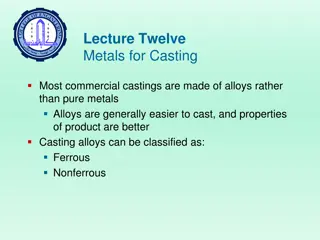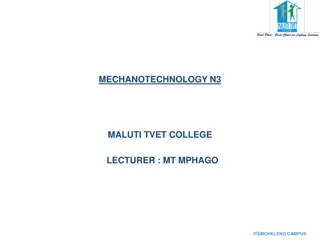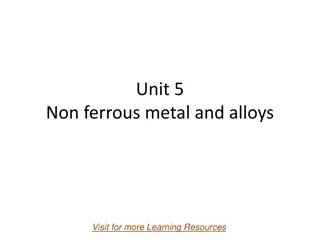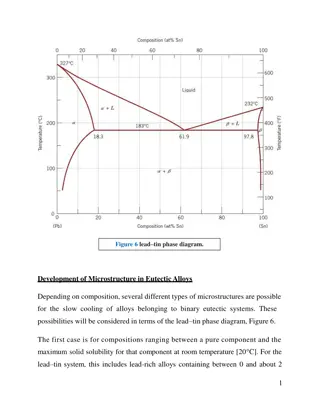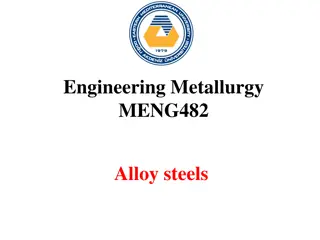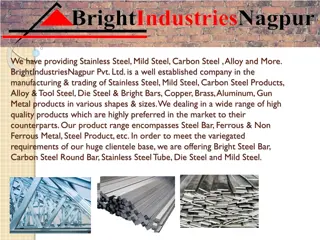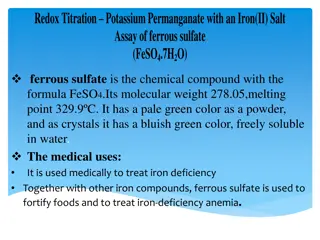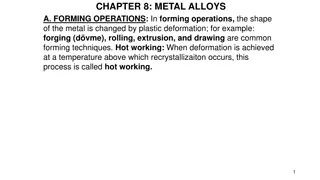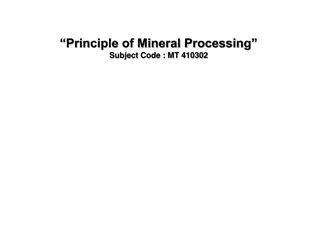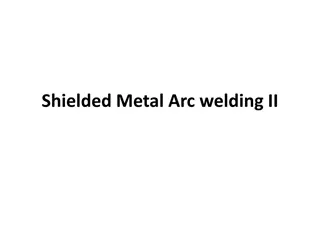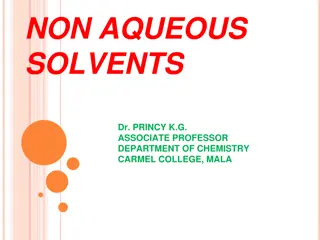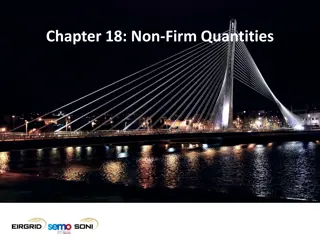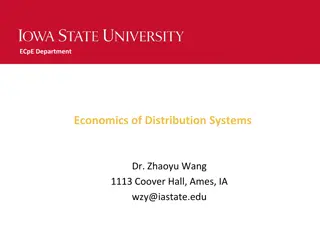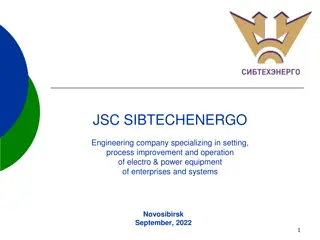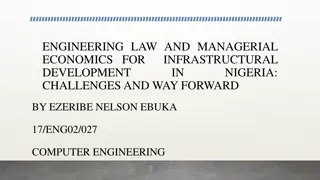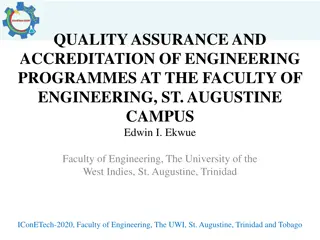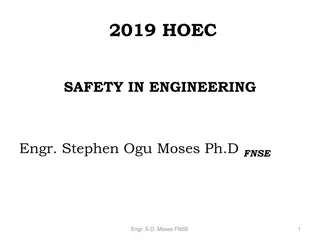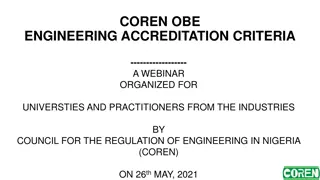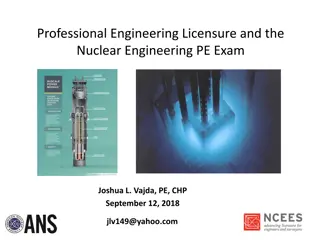Overview of Non-Ferrous Alloys in Engineering Metallurgy
Non-ferrous alloys play a crucial role in engineering metallurgy due to their unique properties and advantages over ferrous alloys. This article explores the classification of materials, the limitations of ferrous alloys, and the properties and applications of non-ferrous metals like copper. Copper, in particular, is discussed in detail, including its grades, properties, and various uses in different industries.
- Non-ferrous alloys
- Engineering metallurgy
- Materials classification
- Copper properties
- Alloy applications
Download Presentation

Please find below an Image/Link to download the presentation.
The content on the website is provided AS IS for your information and personal use only. It may not be sold, licensed, or shared on other websites without obtaining consent from the author. Download presentation by click this link. If you encounter any issues during the download, it is possible that the publisher has removed the file from their server.
E N D
Presentation Transcript
Engineering Metallurgy MENG482 Non-ferrous alloys
INTRODUCTION: Ferrous alloys are consumed in exceedingly large quantities because they have such a wide range of mechanical properties, can be fabricated with relative ease and are economical to produce. However, they possess some distinct limitations,chiefly A relatively high density therefore heavier in weight. A comparatively low electrical conductivityand An inherent capability to corrosion in some common environments. Thus, for many applications it is advantageous or even necessary to utilize other alloy e.g. non-ferrous alloys having more suitable property combinations. Sometime a difference is made between cast and wrought alloy. Alloy that are so brittle that forming or shaping by appreciable deformation is not possible ordinarily, there are classified as cast alloys. on the other hand, those that are enable to mechanical deformation are termed wrought alloys.
In addition, the heat treat ability of an alloy system is mentioned frequently heat treatable designates an alloy whose mechanical strength is improved by precipitation hardening etc. Non-ferrous metals/alloy are not iron-based. The more common non-ferrous materials are the following metallic element and theiralloys. 1.Copper 3.Magnesium 5.Nickel 7.Zinc 8. Cobaltetc. 2.Aluminum 4.Lead 6.Tin
Copper: The main grades of raw copper used for cast copper base alloy are: 1. High conductivity copper having not less than 99.9% Cu. The content may be of the order 0.40% .Pb (lead )And Fe less than 0.005% each. Ag (Silver) 0.002% and Bi (Bismuth) less than 0.001%. Electrolytic copper is used for electricalpurposes. oxygen 2. Deoxidized copper having not less than 99.85% Cu, less than (Arsenic), 0.03% Fe, and 0.003% Bi other elements may be of the order of 0.05% P , 0.01% Pb, 0.10% Ni, 0.003% and 0.005% Ag and Sb (Antimony) respectively. 0.05% As 3. Arsenical de-oxidized copper having 0.4% As, 0.04% P (Phosphorus) and remainingcopper.It is used for welded vessels and tanks. Oxygen free copper contains 0.005% Pb, 0.001% Ni, 0.001% Ag and less than 0.0005% and 0.001% Fe, and Bi respectively. It is melted and cast in non-oxidizingatmosphere. 4.
Copper possesses following properties: Excellent resistance to corrosion. Non-magneticproperties Easy to work, it is ductile and malleable. Moderate to high hardness and strength High thermal and electrical conductivity. It can be easily polished, plated and possesses a pleasing appearance. Resistance to fatigue, abrasion, and corrosion. It can be soldered, brazed or welded. Very good machine ability. Ease of forming alloys with other elements like zn, sn, al, ph, si, ni, etc. Copper is used for the following: Electricalparts Heatexchangers Screw machineproducts For making various copper alloy, such as brass and bronze Household utensils, etc.
Copper Alloys: Copper normally possess excellent corrosion resistance electrical and thermal conductivities and formability. Some copper alloys combine high strength and corrosion resistance, a combination desirable for marine applications. Some copper alloys because of their wearing properties, high hardness or corrosion resistance are used as surfacing metals. Some copper alloys are selected for decorative applications because ofappearance. Elements such as aluminum, zinc, tin, beryllium, nickel, silicon, lead etc. form alloys withcopper. Copper alloys may be classified as: 1. Brasses Alloys of copper and zinc 2. Bronze up to 12% of alloying element 3. Cupronickels alloy of copper and nickel 4. Nickel silvers alloy of copper, nickel and zinc.
BRASSES: Brasses contain zinc as the principle alloyingelement. Brasses are sub-divided into three groups. cu-znallos cu, pb-zn alloys or leaded brass, cu-zn-sn alloys or tinbrass Brass has high resistance to corrosion and is easily machinable.It also acts as good bearingmaterial. Zinc in the brass increases ductility along withstrength. Brass possesses greater strength than copper however it has a lower thermal and electricalconductivity. Various types of brasses are discussed below. (1) GildingMetal (2) CartridgeBrass (3) AdmiraltyBrass (4) AluminumBrass (5) BasisBrass (6) Muntz metal or yellowmetal (7) Leaded 60:40brass (8) Navalbrass
GildingMetal: The gilding metals cover a range from 5% to 15% Zn. And possess shades of color from the red of copper to a brassy yellow. Cartridge Brass: Normally contains 70% Cu and 30% Zn. In the fully annealed condition it has a tensile strength of over 300 N/mm2 AdmiraltyBrass: Admiralty brass contains Cu 71%, Zn 28% and Sn 1%. The small amount of tin added to brass improves its resistance to certain types of corrosion. AluminumBrass: It contains 76% Cu, 22% Zn and 2% Al a little arsenic is added to inhibit dezincification. BasisBrass: It contains copper 61.5 64%, the remainder beingZinc. Basis brass is used for press work where a relatively cheap material is required and the main commercial forms are sheet, strip, and wire.
Muntz metal or yellowmetal: It contains 60% of copper and 40% of zinc and is essentially a hot working material. It is manufactured in the form of hot rolled plate and hot rolled or extruded section in a great variety of shapes and sizes. Yellow metal is frequently used as a brazing alloy forsteel. Leaded 60:40brass: It the chief material fed to automatic lathes and similar machines. Usually in the form of extrudedbar. Lead is added to Cu-Zn alloy to promote machinability. The lead content ranges from about 0.5% to as much as 3.5%. Navalbrass: It contains Cu 60%, Zn 39.25% and Sn 0.75%. The purpose of tin is toimprove the resistance to corrosion.
Bronzes: Bronze is a broad term defining an alloy of copper and elements other than nickel orZinc. Bronze is basically an alloy of copper and tin. Bronze possesses superior mechanical properties and corrosion resistance than brass. Bronze is comparatively hard and it resists surface wear. Bronze can be shaped or rolled in to wire rod and sheets. Different types of bronze are: (1) Phosphor bronze: The most important copper-tin alloys are those which have been deoxidized with phosphorus during the refining process and hence are known as phosphor bronze. The amount of residual phosphorus may range from a trace to about 0.35% or even higher in some specialgrades.
The excess phosphorus, which exists in solid solution, materially increases the hardness and strength of the alloy, but it does so at the expense of ductility. In amounts greater than 1.0% phosphorus causes excessive brittleness and impairs surface appearance but affords a good bearing surface, as is evident by the use of high phosphorus bronze compositions for gears and other machine parts subject to wear. A phosphorus bronze containing approximately 4% each of tin, lead and zinc has excellent free cuttingcharacteristics. Standard phosphor bronze for bearing applications contains 90% Cu, 10% Sn, and 0.5% P, in sand cast condition it has a tensile strength of 220-280 N/mm2 and % elongation 3 to 8 %. Phosphor bronze for gears contains 88% Cu, 12% Sn, 0.3% Zn, 0.50% Pb and 0.15 P. in sand cast condition, it has a tensile strength of 220-310 N/mm2 and 5-15% elongation. This alloy is also utilized for general bearings, where its rigidity of advantages.
(2) Aluminum bronze: Have the following compositions: Cu Al 89 7 91 6.8 Aluminum bronzes possess the following properties good strength high corrosion resistance good heat resistance good cold working properties. Aluminum bronze finds the followinguses: Bearings, gears, slide valves, imitations jewellery, valve seat, propellers, cams, pump partetc. Fe 3.5 1.5-3.5 Sn 0.35 - Mn0.1 - 1(max)
(3) Silicon bronze: Have the following compositions: Si 1 4% Mn 0.25 1.25% Lead when added as 0.5% improves machineability. Silicon bronzes posses high strength and toughness as that of mild steel and corrosion resistance as that ofcopper. Silicon bronzes find the followinguses. Bearings, roll mill sleepers, turntable bushing marine hardware, ways and gibs, screw down nuts, boiler parts, Die cast parts etc. Fe 0.5 1.0% CuBalance.
GunMetal: Gun metal is an alloy of copper, tin andZinc. Zinc cleans the metal and increases itsfluidity A small amount of lead may be added to improve castability and machiability. (1) Admirality gun-metal: It contains 10% Sn, 2% Zn, 1.5% max pb, 1.5% max Ni, and balance Cu, it has tensile strength of 260-340 N/mm2. It is widely used for pumps, valves and miscellaneous casting and is also used for statuary. (2) Nickelgun-metal: It contains 7% Sn, 2.25% Zn, 0.3% pb, 2% max Ni when sand cast it has a tensile strength of 200-270 N/mm2. This is among the most widely used grades, particularly where pressure tightness is required. In general gun metal is used for Bearings, steam pipefittings, marine castings, Hydraulic valves and gears,etc.
Bearing materials: Bearings support moving parts, such as shaft and spindles, of a machine or mechanism. Bearings may be classed as. Rolling contactbearings. Plainbearings. Rolling contact bearings are almost invariant by made of steel that can be hardened after machining both plain carbon and alloy steel are employed for differentapplications. For making plain bearings, an extremely wide range of materials is available and will be discussed below. Properties of BearingsMaterials: A bearing material should: Possess low co-efficient of friction. Provide hard wear resistance surface with a tough core. Have high compressive strength. Have high fatigue strength. Be able to bear shocks and vibrations. Possess high thermal conductivity to dissipate heat generated due to friction between the bearing and the rotating shaft. Possess adequate strength at high temp. Be such that it can be easily fabricated.
Aluminum and Aluminum Alloys Aluminum is a silvery white metal and it possesses the following characteristics. 1. It is a light metal, with a density about a third that of steeland brass(2.7gm/cm3) 2. Its electrical conductivity is about 60% of that of copper. 3. It has high thermalconductivity. 4. It is ductile andmalleable. 5. It has a non magneticand non sparking incharacter. 6. Easy formability and machinability. 7. It is good conductor ofheat.
Types of Al Alloys Aluminum alloy Can beclassified. 1. Wroughtalloy 2. Castalloy 3. Heat treatable alloy 4. Non-heat-treatable alloys. Aluminum alloycontain 1. Al-Mn 2. Al-Mg 3. Al-Mg-Mn 4. Al-Mg-Si 5. Al-Cu-Mg 6. Al-Cu-Si 7. Al-Cu-Mg-Pb 8. Al-Mg-Si- Pb 9. Al-Zn-Mg-Cu
1. Percent composition of few wrought alloys are: 1. 4.4 Cu, 0.6 Mn, 1.5 Mg, balance Al (Duralumin) 2. 0.12 Cu, 1.2 Mn, Balance Al(Magnalium) 3. 2.5 Mg, 0.25 Cr, Balance Al(Hindalium) 4. 0.6 Si, 0.27 Cu,1.0 Mg, 0.2 Cr, Balance Al 2. Percent composition of few cast alloys are: 1. 12 Si, rest Al(LM-5) 2. 4.5 Cu, 5.5 Si, restAl 3. 4. 4 Cu, 3 Si, restAl 3.8 Mg, 1.8 Zn, restAl 3. Percent composition of few heat treatable alloys are: 1. 3.9-5.0 Cu, 0.2-0.8 Mg, 0.5-1.0 Si, 0.5-1.0 Mn, restAl 2. 0.5-1.2 Mg, 0.7-1.3 Si, 0.4-1.0 Mn, restAl 3. 0.4-0.9 Mg, 0.3-0.7 Si, restAl 4. Percent composition of few non heat treatable alloys are: 1. 0.8-1.5 Mn, RestAl 2. 1.7-2.4 Mg, rest Al(LM-10) 3. 10-13 Si, restAl 4. 5.0-5.5 Mg, 0.6-1.0 Mn, 0.05-0.20 Cr, restAl
Use of Al and Al-alloys 1. Transportation industry- Structural frame work, engine parts, decorative features, hardware, doors, window frame, furnishing andfitting. 2. Overhead conductor and heat exchangerparts. 3. In food industry, Al and its alloy find application as preparation equipment, refrigeration, storage containers, bakery equipment, shippingcontainer. 4. Cryogenicapplication. 5. As heavy duty structure such as travelling Crain, hoists, conveyor support,bridges. 6. In process industry, handle organic chemical petrochemicals and drug.
Magnesium and Magnesium Alloys Magnesium is a silvery white metal and has the lowest densityof the common structuralmaterials. Properties: 1. High strength to weight ratio. 2. Good fatiguestrength. 3. Good dimensional stability inservice. 4. Good dampingcapacity. 5. Relative high electrical conductivity. 6. High thermalconductivity. Uses: 1. For making parts such as airframes, engines, gear boxes, flooring, seating etc. for the helicopters, aero planes,missiles. 2. For material handling equipment such as hand trucks,conveyors, foundry equipment. 3. For storage tank ,electric drills, chain saws, power hammeretc. 4. Moving parts of textile machines and printingequipment. 5. Binocular and camerabodies. 6. In the production of uranium, beryllium, zirconium, titaniumetc. 7. Typewriters, dictating machine, calculatoretc.
Types of magnesium alloys: 1. Dow metal It contains 90% magnesium, 10% Aluminium and asmall addition ofmanganese It used in air craft industries and automobile industries It us extremely hard and can welded andmachined 2. Cast alloys of magnesium Al 8, Zn 0.5, Mn 0.3 and mgbalance Al 8, Zn 0.5, Mn 0.3, Be 0.0015 and mgbalance 3. Wrought alloys of magnesium Zn 3.0, Zr (Zirconium) 0.6 and mgbalance Th 0.8, Zn 0.6, Zr 0.6 and mgbalance
Titanium and itsAlloys Characteristics: They are 40% lighter than steel and 60% heavier than aluminum. The combination of moderate weight and high strength give titanium alloys the highest strength to weight ration of any structuralmetal. Melting point of titanium is higher thaniron. It has low thermalconductivity. Titanium has good corrosion resistance. Its thermal coefficient of expansion islow. Its electrical resistivity is alsohigh. Types of titanium alloys 1. Alpha alloys (alloying elements Al, Sn, Zr, V,Mo) 2. Betaalloys 3. Alpha and betaalloys
Lead and its alloys Properties of lead: Resistance to corrosion and low meltingpoint It ispoisonous Heavy weight, high density, softness, malleability High coefficient of expansion and low electrical conductivity Application: For radiation shielding and production of paints For weight in counterweights It is used in copper alloys for good machinability Lead based alloys: It is applied where cheap and corrosion resistance materialis required. An alloy contains 8 to 10% Pb are used as bearing metals.


